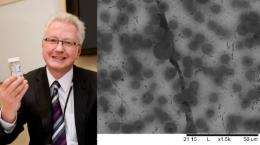January 31, 2011 weblog
New hydrogen storage material could be added directly to fuel tanks

(PhysOrg.com) -- If hydrogen is to ever play a role in powering vehicles on a large-scale, researchers must not only find a way to produce hydrogen, but also a safe method to store it. Currently, storing hydrogen requires either very low temperatures or very high pressures, both of which are expensive, require large amounts of energy, and involve safety risks. Now a new spin-out company from Rutherford Appleton Laboratory in the UK called Cella Energy Ltd. is developing an inexpensive, practical method to store hydrogen that could be added directly to conventional automobile engines. The method could lead to clean hydrogen fuels for vehicles that can be pumped like gasoline, fuel additives to lower emissions in vehicles with minimal modifications, and even batteries that allow laptops to last a week between charges, among other uses.
The new storage technique stems from research performed by Professor Stephen Bennington, Dr. Arthur Lovell, and others at Rutherford Appleton Laboratory, the University College London and the University of Oxford. The researchers developed a way to make tiny microfibers that are just 2-50 nm in diameter using low-cost automated processes called electrospinning and electrospraying. The microfibers can then be woven together to create a micro-porous polymer that resembles tissue paper, or a similar technique can be used to make micro-beads. The tiny pores in the polymer can encapsulate a variety of hydrides, which are chemical compounds that include hydrogen and other elements. When the hydrides are trapped inside the polymers, the hydrogen can be rapidly desorbed (released) at low pressures and ambient temperatures. According to Cella Energy, the micro-porous polymers can store as much hydrogen for a given weight as high-pressure tanks.
The micro-beads, which also encapsulate hydrides, are especially interesting for vehicular applications. The micro-beads resemble a fine powder and could potentially be poured and pumped like a fluid into vehicles’ fuel tanks. The company explains that the encapsulated hydrogen could be safely used in either an internal combustion engine or fuel cell. Once the hydrogen is desorbed from a bead, the empty bead is stored in a separate lightweight plastic tank in the vehicle. When the vehicle needs to be refueled, the waste beads are removed from the vehicle and taken elsewhere to be rehydrided and recycled. Unlike hydrogen stored in high-pressure cylinders, new micro-beads could be refueled into vehicles just like vehicles today are refueled with gasoline. The company adds that the hydrogen storage materials are actually safer to handle than gasoline.
According to the CEO of Cella Energy, Stephen Voller, the technology has the potential to provide a driving range of 300-400 miles between fueling. As for pricing, an article on Gizmag says that the storage materials could lead to synthetic fuel that costs just $1.50 per gallon, although it’s not clear where that price comes from.
During the past year, the researchers at Cella Energy have been experimenting with ammonia borane as the hydride. When encapsulated, the accessible hydrogen content is 6% by weight. Although this percentage exceeds the DOE target of 4.5wt%, it is less than that of ammonia borane in its normal state. However, one of the advantages is that the hydrogen in the new polymer is desorbed an order of magnitude faster and at more convenient temperatures than ammonia borane in its normal state. The researchers noted that, while this will work for proof-of-concept work, it is too expensive to make for a commercial product and cannot be easily recycled. The company is currently looking into different hydrides that have slightly lower hydrogen contents, but that could be recycled many hundreds of times.
At this point, Cella Energy has at least one investor, the chemical company Thomas Swan and Co. Cella Energy hopes to perform the first road tests next year, and, if they go well, could commercialize the product within the next five years.
More information:
www.cellaenergy.com
via: Gizmag
© 2010 PhysOrg.com

















